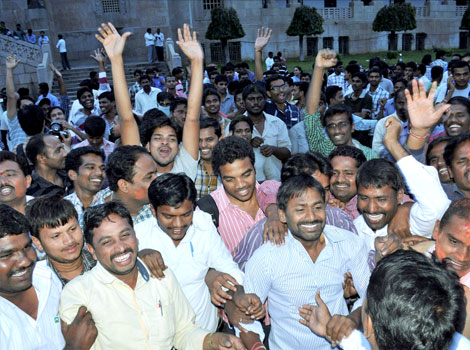
New Delhi, Jul 31: The ruling UPA on Tuesday decided to split Andhra Pradesh and create Telangana, acceding to a 45-year-old demand for statehood in a bid to win local support and stymie political rivals ahead of the 2014 general elections.
Telangana, likely to be born as the 29th state of India sometime next year, will comprise 10 out of the 23 districts of united Andhra. For the first decade, Hyderabad, the capital and jewel in the crown, will be shared by Telangana and the rest of the state, which will retain the name Andhra Pradesh.
The move to create the new state comes nearly four years after then home minister P Chidambaram announced in December 2009 that Congress wanted to initiate the process; the party’s resolve wilted in the face of fierce opposition from Andhra.
But this time around, the looming general elections strengthened its spine, and support from the opposition BJP — also keen to win brownie points ahead of the polls —should ensure smooth passage through Parliament.
“Today, our dreams have come true. We salute those who have sacrificed their lives for Telangana,” Ponnam Prabhakar, Congress MP from Karimnagar, which falls in the new state, told HT.
Prabhakar estimated that over 1,000 people have died in the struggle to create the state.
With this move, the Congress aims to contain the popular Jaganmohan Reddy to Andhra Pradesh and win the majority of the 17 Lok Sabha seats in Telangana.
It seems to have given up on Andhra Pradesh, which sends 25 MPs to Delhi but is now seen as Jagan territory.
Another potential rival to the Congress in Telangana, the Telugu Desam Party, has shot itself in the foot by opposing the demand for the state until last year.
The Congress leadership has come to the conclusion that Telangana is “emotionally disintegrated” and “only division could save” the party in the 2014 polls, a senior leader said.
On Tuesday, Congress president Sonia Gandhi opened the Congress Working Committee meeting giving a historical perspective of the issue. PM Manmohan Singh endorsed Gandhi’s views and said the move will help in the equitable development of all the regions of the state.
Singh is understood to have earlier been opposed to the creation of Telangana due to intelligence agency apprehensions that it will become a breeding ground for Maoist and Muslim terror groups.
The creation of the state could spawn similar demands from others. Even at the CWC meeting, MP Mukul Wasnik raised the issue of Vidarbha, which he wants split from Maharashtra.
The demand was endorsed by another MP, Gurudas Kamat. Other demands for states include Gorkhaland and Bodoland in the north east.
The bill to create Telangana is expected to reach Parliament in the next four to five months, probably in the winter session. Before this it will go to President Pranab Mukherjee and the Andhra assembly.
What's Telangana about:
1. Telangana would be the 29th state of Independent India.
2. The Telangana region comprises 10 districts: Hyderabad, Adilabad, Khammam, Karimnagar, Mahbubnagar, Medak, Nalgonda, Nizamabad, Rangareddy, and Warangal.
3. Apart from Telangana, Andra Pradesh consists of two other parts namely Coastal Andra and Rayalaseema.
4. According to sources, violence that came along with the Telangana merger demand has consumed more than 1000 lives over last three years, which includes numerous cases of self immolation.
5. The sharing of the capital city Hyderabad had long been the bone of contention in the separation struggle.
6. Pro-Telangana people put forward a notion that 45% of the state income comes from Telangana but when it comes to utilization of funds, its share is only 28%.
7. Proponents of a separate Telangana state cite perceived injustices in the distribution of water, budget allocations, and jobs.





Comments
Add new comment